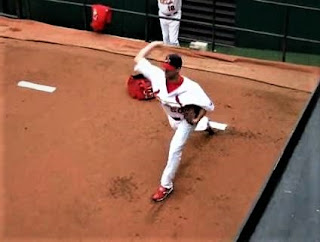A “2-Pitch Performance Threshold” cuts through the clutter to give you a very accurate, exceptionally reliable and extremely insightful look into your pitching.
Your “2-Pitch Performance Threshold” simply calculates the
frequency with which you deliver 2 pitches in a row directly into your
Catcher’s target.
You begin each pitch intending to deliver your pitch into your
target with the movement your Team expects. Your "2-Pitch Performance
Threshold" counts the number of times you accomplish what you set out to
do.
- An engaged lower body means you perform above the “2-Pitch Performance
Threshold”.
When you show you can execute 2 pitches in a row into your Catcher's target, not only do you perform above the "2-Pitch Performance Threshold", but you’ve grown to trust your lower body to command every pitch into your target all the time.
- Without your lower body influencing your throwing action, you’re going to perform below the “2-Pitch Performance Threshold” all the time.
Luck aside, when you can't execute 2 pitches in a row into your Catcher's target, not only do you live below the "2-Pitch Performance Threshold", but you’re frantically trying to figure out the skills all "2-Pitch Performance Threshold" pitchers already know.
When you show you can execute 2 pitches in a row into your Catcher's target, not only do you perform above the "2-Pitch Performance Threshold", but you’ve grown to trust your lower body to command every pitch into your target all the time.
- Without your lower body influencing your throwing action, you’re going to perform below the “2-Pitch Performance Threshold” all the time.
Luck aside, when you can't execute 2 pitches in a row into your Catcher's target, not only do you live below the "2-Pitch Performance Threshold", but you’re frantically trying to figure out the skills all "2-Pitch Performance Threshold" pitchers already know.
A "2-Pitch Performance Threshold" subtly measures much more than pitch command.
Your command is above the 2-pitch threshold when you rely on your body to spontaneously deliver every pitch very close to your target all the time orYour command is below the 2-pitch threshold when you have even the slightest concern your next pitch will miss your target over the plate.Your velocity is at its max when you clear your front shoulder as you finish your stride or
Your velocity is below your max when, to remain competitive, you need to finish your stride with your front shoulder pointing toward your target.Your ball movement is as good as it’ll ever get when your command and velocity are at their threshold or
Your ball takes a predictable path into your target when your command and velocity are below their threshold.No matter the pitch called, your arm speed shouts fastball and your hand comes through a very productive release window or
Depending upon the pitch called, you have no choice but to have your arm speed and release window tip your next pitch.
When you know how to regularly deliver 2 or more pitches
directly into your target, your lower body forces you to challenge every opponent
on every pitch to make solid contact with any pitch.
Making your throwing arm a spontaneous reaction to your
lower body only requires a couple of simple adjustments. Contact me to find out how it’s done.
Skip Fast
Pitch Location Expert
Professional Pitching Institute
Professional Pitching Institute
E-Mail: skip@propitchinginstitute.com
Cell or Text: 856-524-3248
Cell or Text: 856-524-3248
Copyright © 2018




